1st Semester MA Interior Architecture
WiSe 2023/24 - HFT STUTTGART
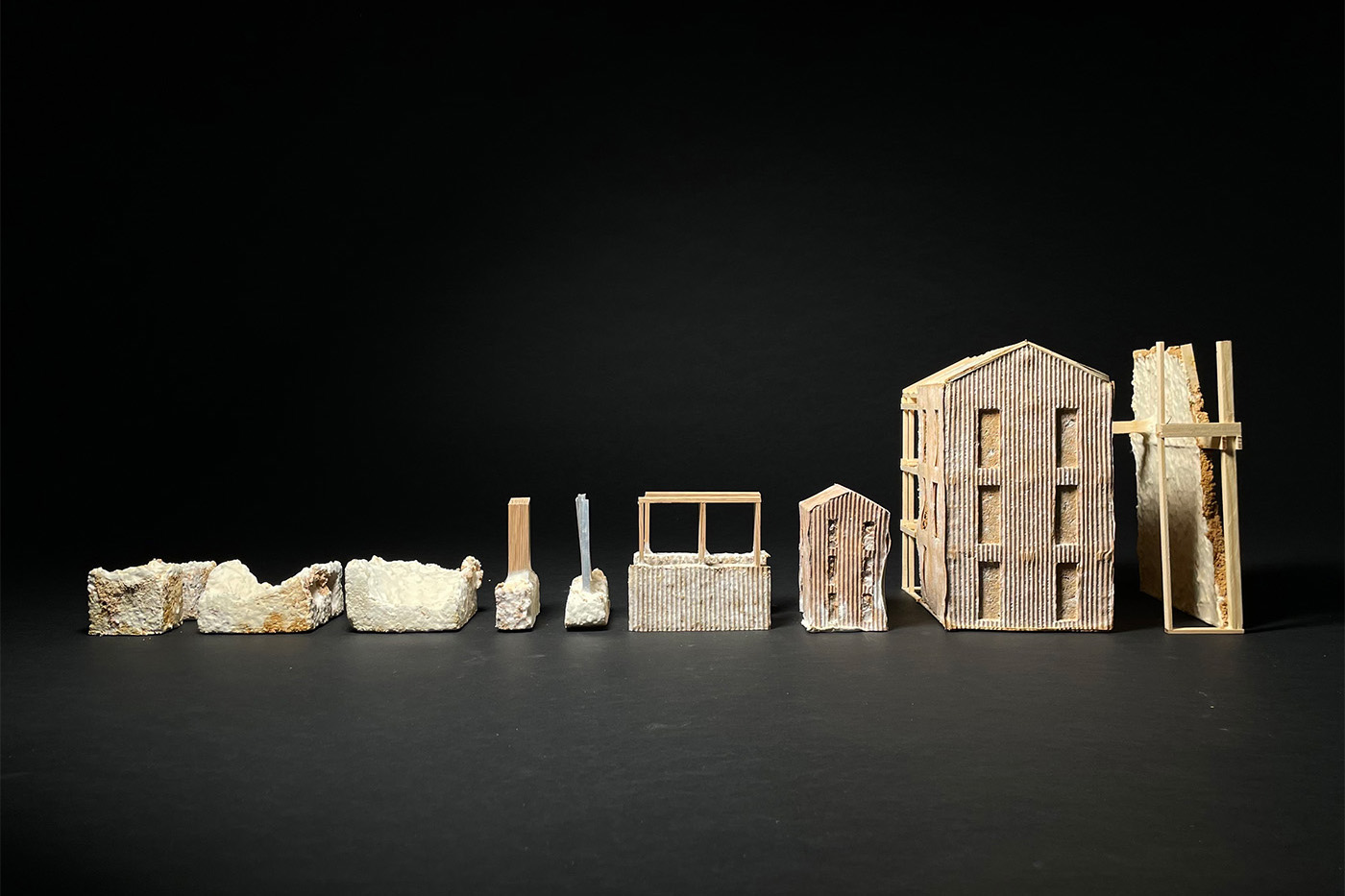
MYCELIUM
MODEL
MAKING
How can fungal mycelium be used as a biological alternative for modelling in architecture and design? Awareness of sustainable building materials is growing steadily – how can we also address this in model making? Expanded or extruded polystyrene (EPS/XPS) is still frequently used here – a crude oil-based and environmentally harmful plastic. As an alternative, we are investigating mycelium, the underground „root system“ of fungi, whose technical properties are similar to those of plastics in several aspects.
In the winter semester 2023/24, students first analyzed which of the waste streams generated within the university were suitable as a substrate for mycelium cultivation during the „beyond the lab“ workshop with biodesigner Miriam Josi M.Sc. from the Paris-based studio aléa. Sawdust from our carpentry, which would normally be disposed of and thermally recycled, proved to be particularly suitable.
For the subsequent semester design project, the students each selected an aspect of the mushroom material that they found particularly exciting – e.g. a method of mold making, a processing or finishing technique. Based on this, they decided on at least one suitable common model making scale, in which they then designed and created. The aim was to explore and demonstrate (proof of concept) the wide variety of model-making possibilities with this natural composite using different typologies: from furniture or detail mock-ups, to pavilion, interior, sectional, recessed, facade and building models, through to site or urban planning models. The following scales were used: 1:1 / 1:5 / 1:10 / 1:20 / 1:25 / 1:50 / 1:100 / 1:200 / 1:500
At the beginning, groups were formed to find out what characterizes the respective scale, which materials are usually used to build these models and which particularly successful models exist (best practice). Projects were then conceived in order to find their realization in the model. The focus was clearly on the materiality / construction with mycelium or the selected partial aspect. Attention should be paid to the ecological meaningfulness of the idea. Which material does the mycelium in the model stand for in reality or 1:1 – for another sustainable building material, or even for itself? How can the inactivated material be processed, separated, joined and refined? Or is even the living organism suitable as a design tool? Not only the final results were documented, but also previous material tests and processes by means of a laboratory journal and photos.
Many thanks to Tyroler Glückspilze for their generous support.
The semester design was supervised by the fungi researchers Julia Krayer M.A. and Lina Vieres B.Sc. of Fraunhofer UMSICHT, as well as the academic assistant Dipl.-Des. Melissa Acker.
initiation, coordination & supervision

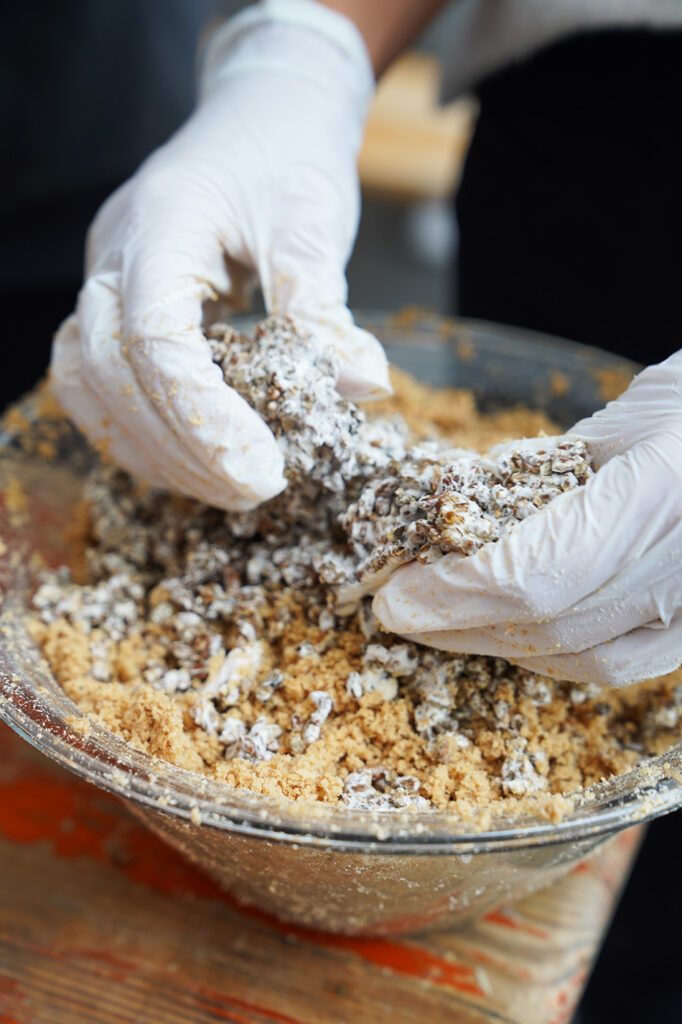
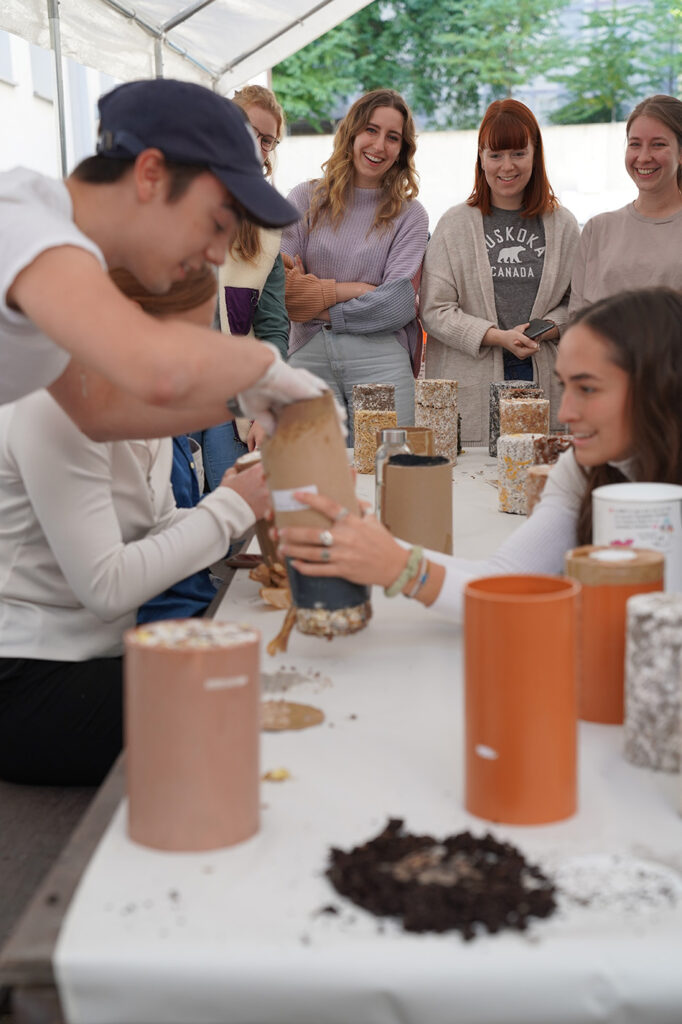
MYCO LAB
An improvised „Myco Lab“ was set up from predominantly reused elements under the direction of Dipl.-Des. Melissa Acker and with the active support of the HFT workshop team Romano Bianchi, Willi Mauch and Holger Bitterberg, accompanied by Jürgen Aldinger, to provide the necessary conditions for mushroom cultivation.
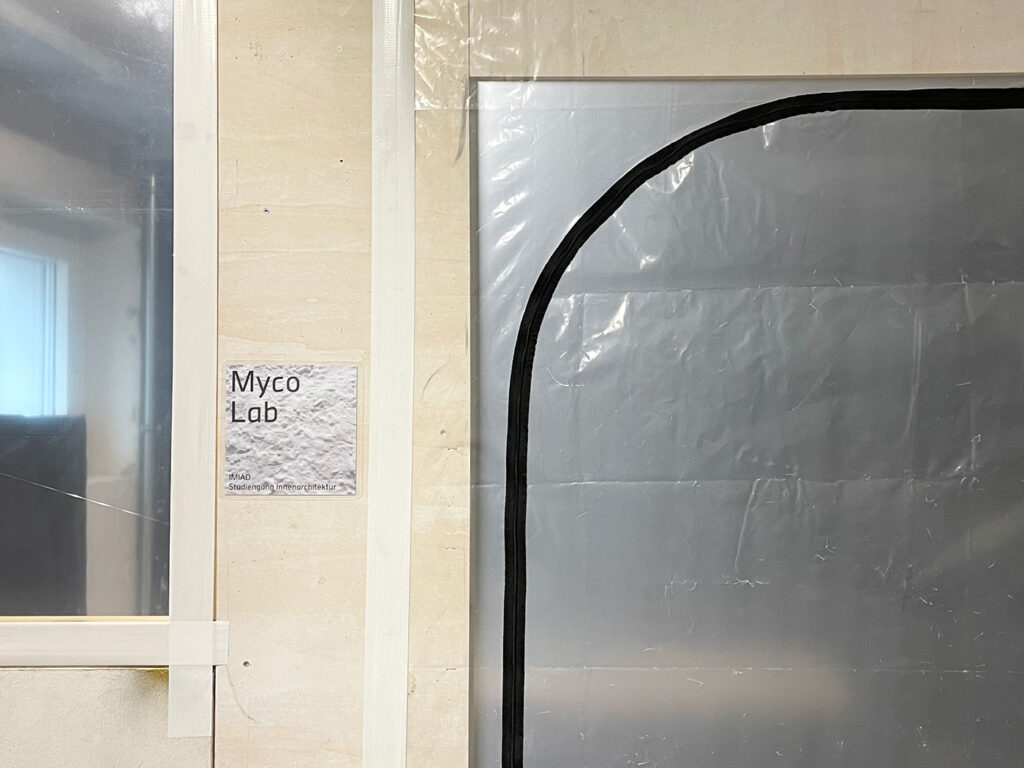
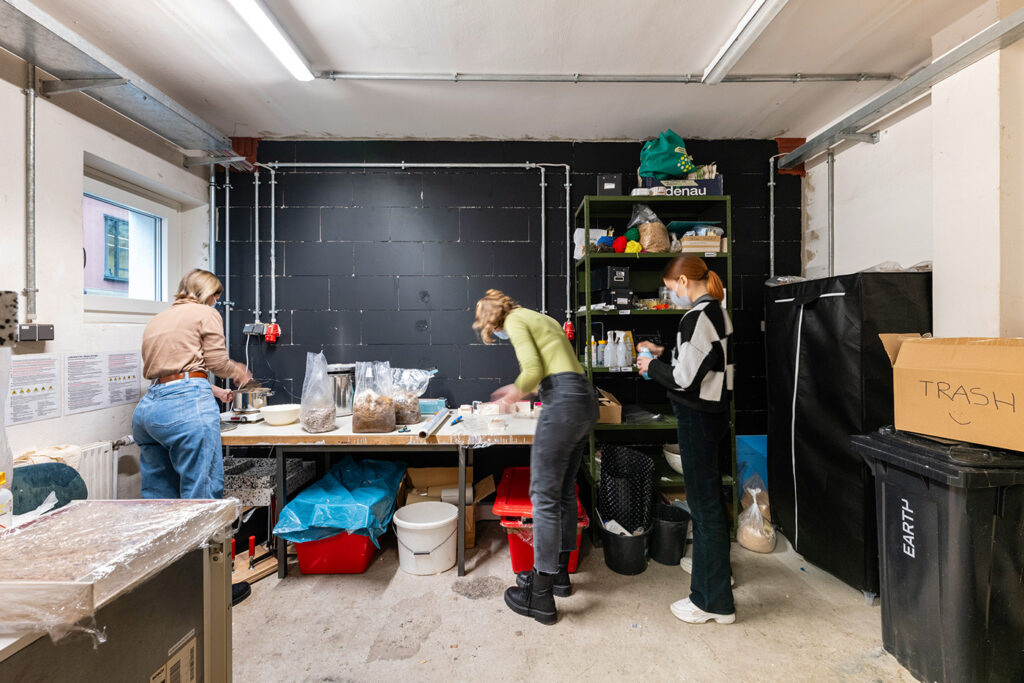
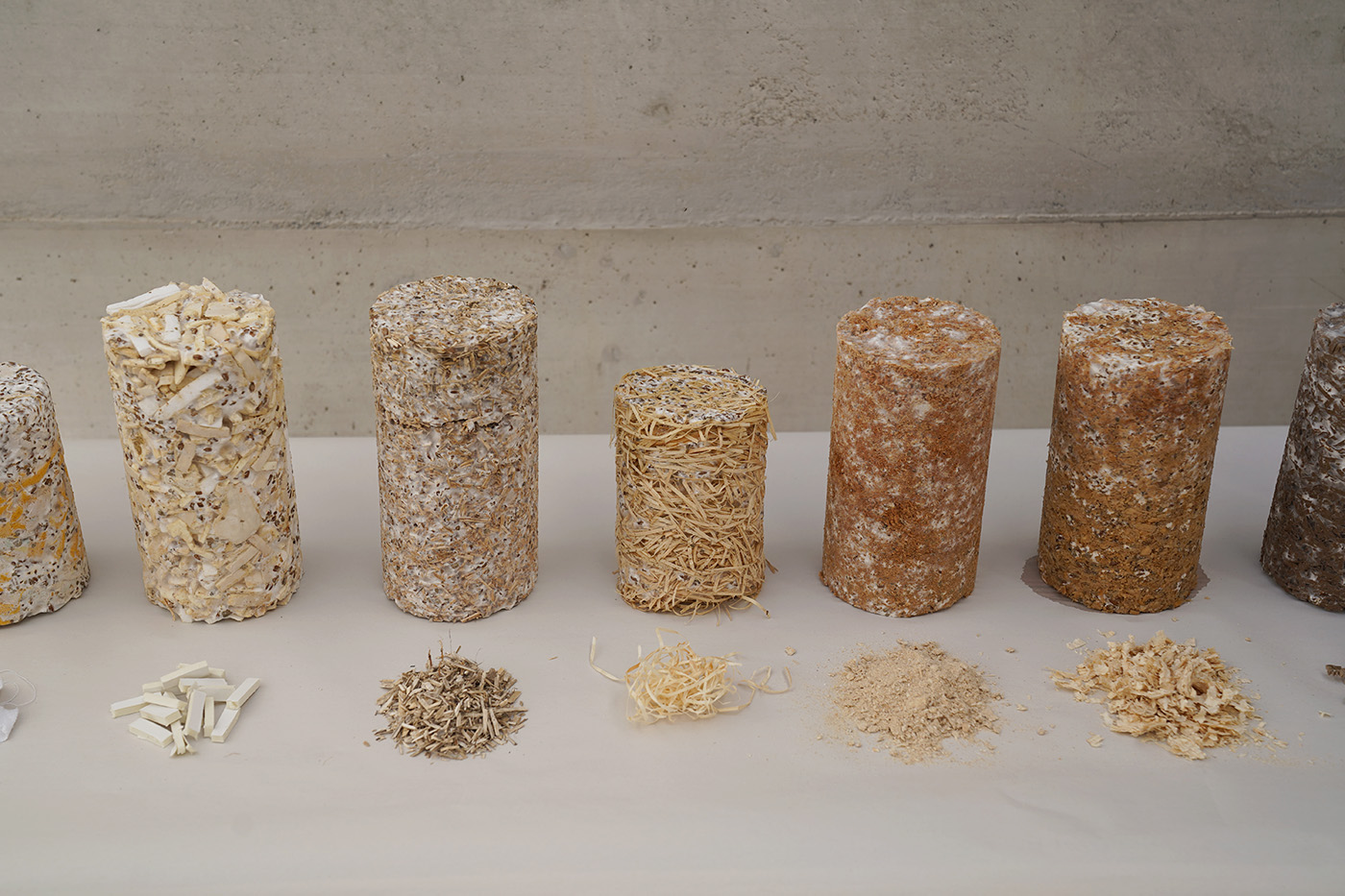
„KOS“ by Afra Gölzer & Amira Klimpel
Based on the characteristics of mycelium, the project reflects the architectural connection with nature. The aim was to design a vacation village in an almost untouched area in Norway that interacts respectfully with the environment and invites its guests to immerse themselves in it. The intention is to create a minimum impact design by using building materials and furniture that meet criteria of sustainability and regionality. The model making with mycelium also follows these principles and is intended to show how this material can become a realistic alternative to conventional synthetic model making materials in the future.
1:500 terrain model, 1:50 scale model with furniture
materials used: reishi mycelium, fruiting bodies, finn board, (stained) birch wood, clay and sand mixture, wood glue, acrylic glass, sugarglass
substrate: sawdust from HFT carpentry, smoked beech chips
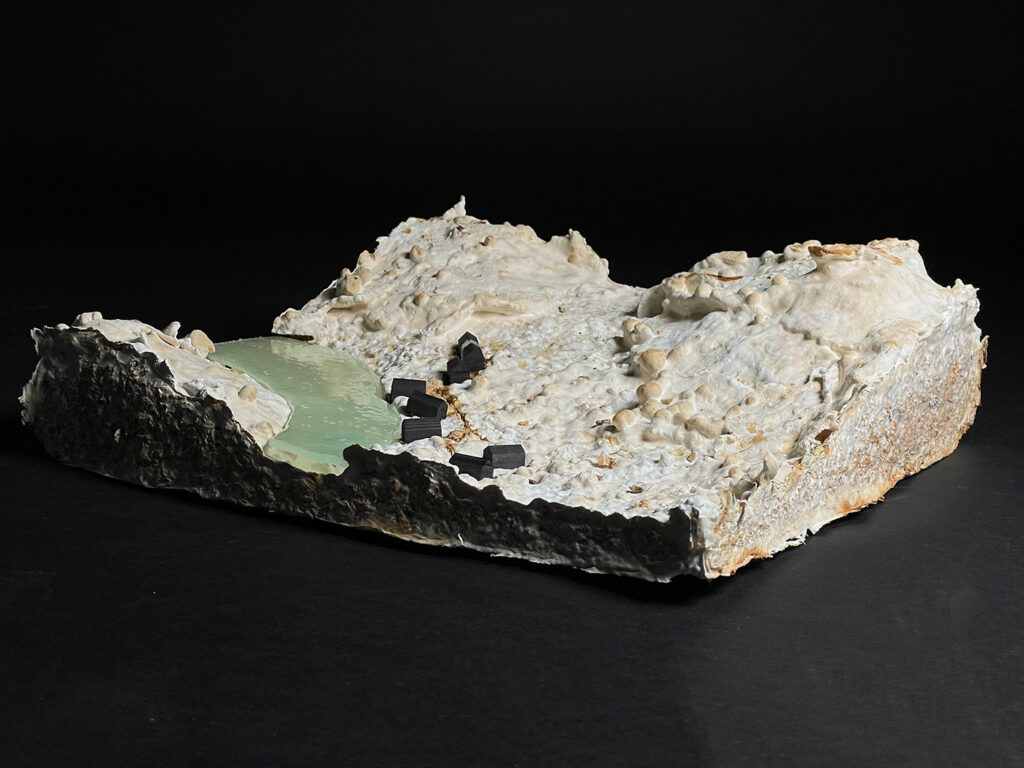

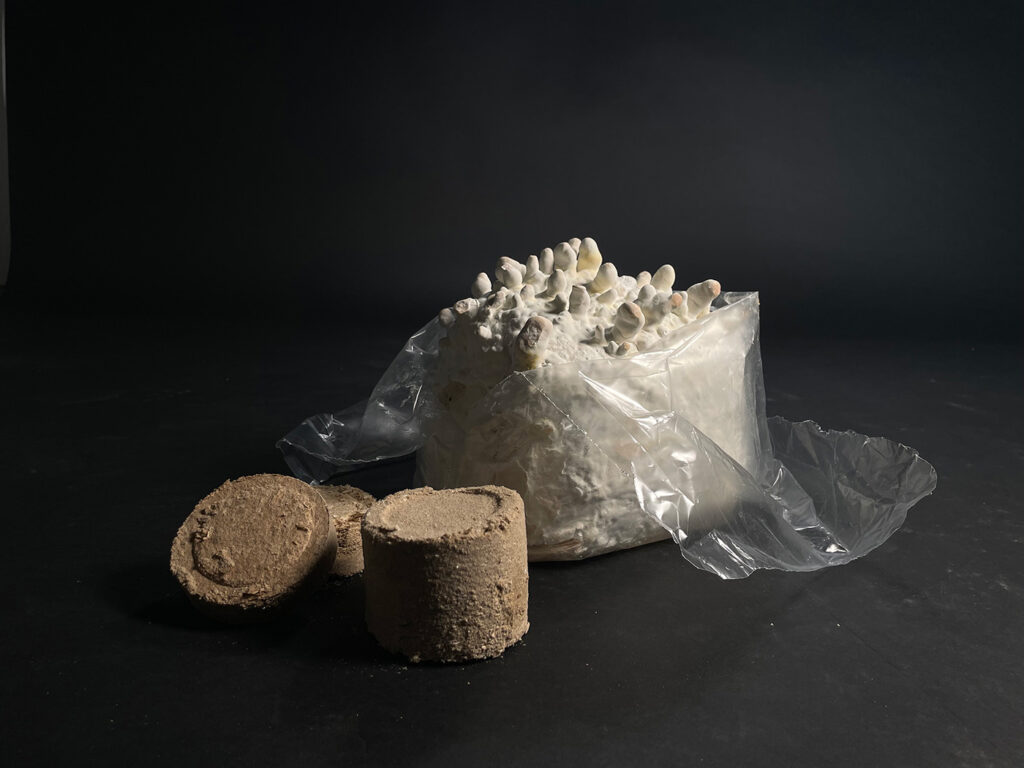
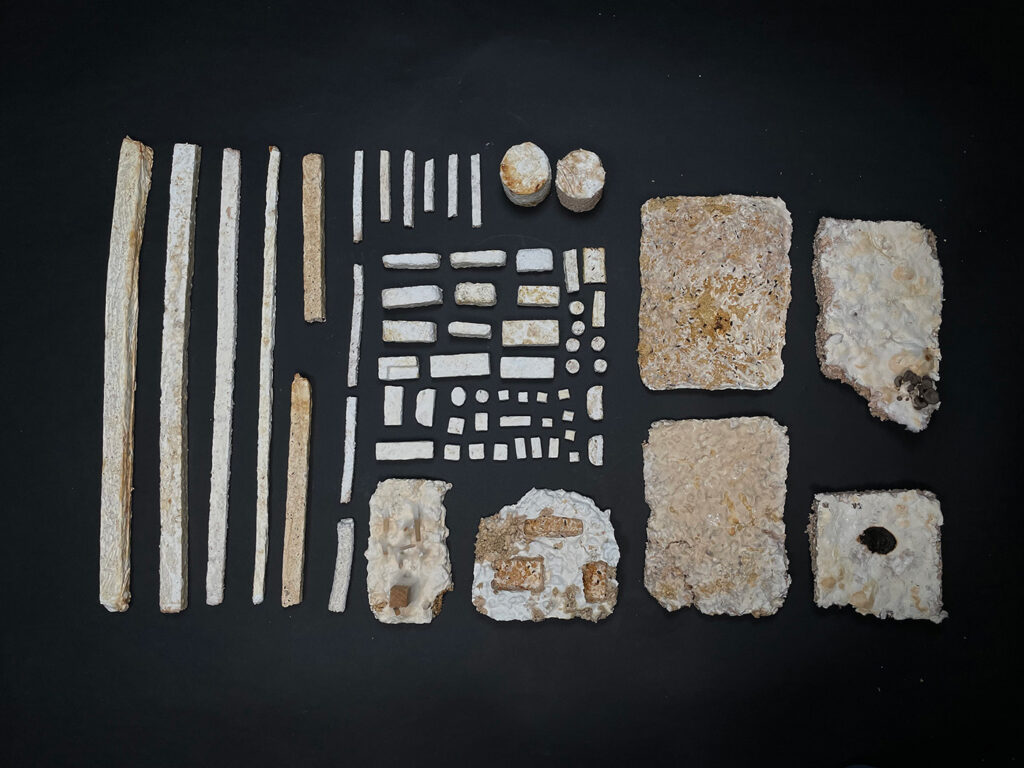

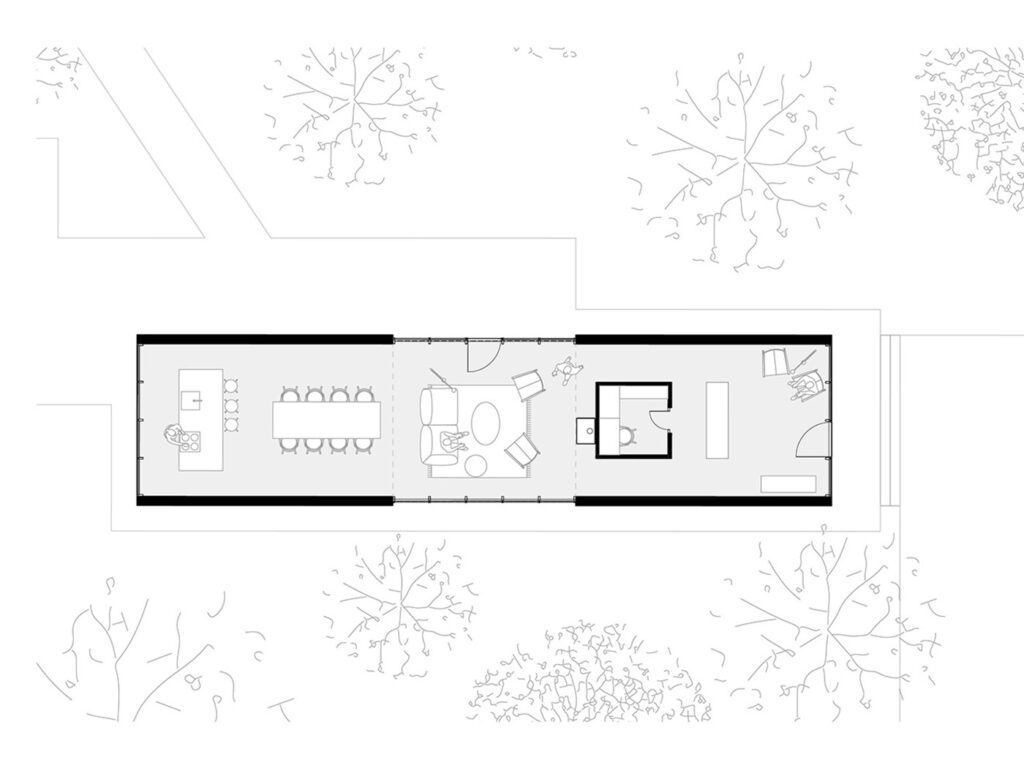
„GROWING IN – MYCELIUM CONSTRUCTION MODEL“ by Katharina Mayer
The property of independent growth of mycelium is very suitable for a construction-sectional model, which means that one part of the model shows the substructure and the other part shows the closed facade. From this idea a building design with a wooden pincer construction developed. This contains both residential and commercial space to counteract the housing and tradesman shortage. The planned mycelium insulation in the building serves as a link between the design and the mycelium model, which, like all other materials used, is sustainable and recyclable. The draft therefore addresses not only social but also sustainable aspects.
In the model, the substructure is built manually and then placed in a mold with various substrates and the mycelium. Now the mycelium grows by itself through all the components and binds them together tightly. In the end, a 1:50 building model and a 1:20 facade section model were created.
To avoid using plastic in mold making, a test was carried out with old cardboard and some adhesive tape. The cardboard was used to make the mold, the facade and the base. The polystyrene normally used was therefore replaced with recycled paper and no new materials were purchased. A simple – sustainable – model construction method.
1:50 construction model, 1:20 wall section model
materials used: mycelium, sawdust, wood, corrugated cardboard
substrate: very fine sawdust from a carpentry
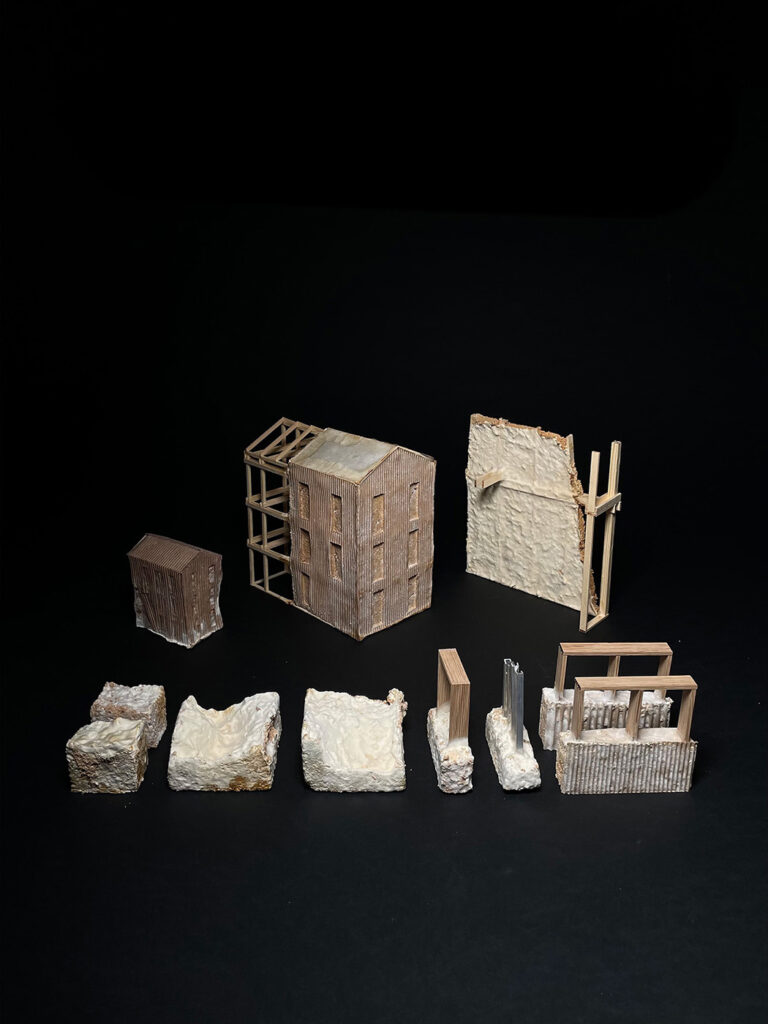
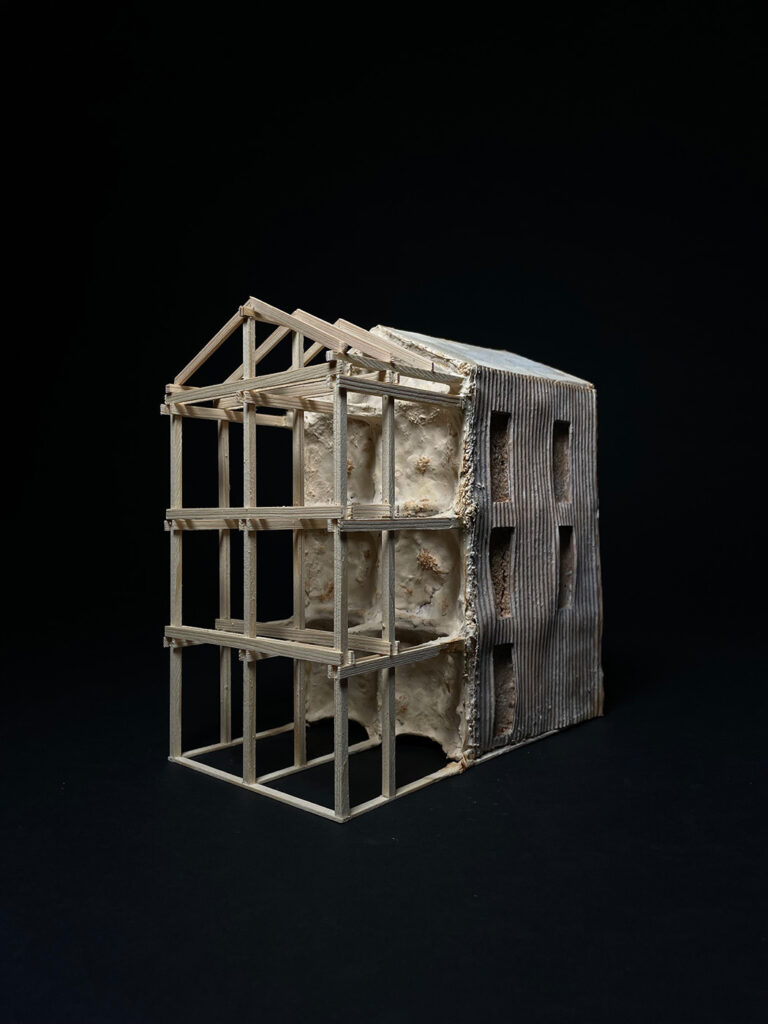
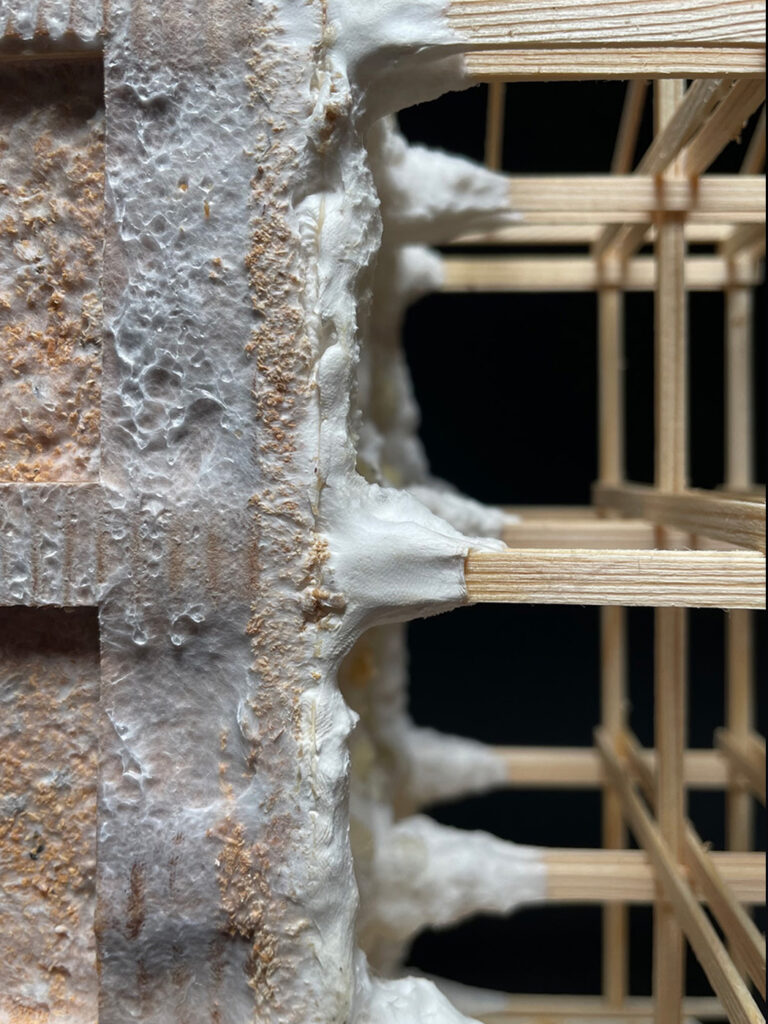
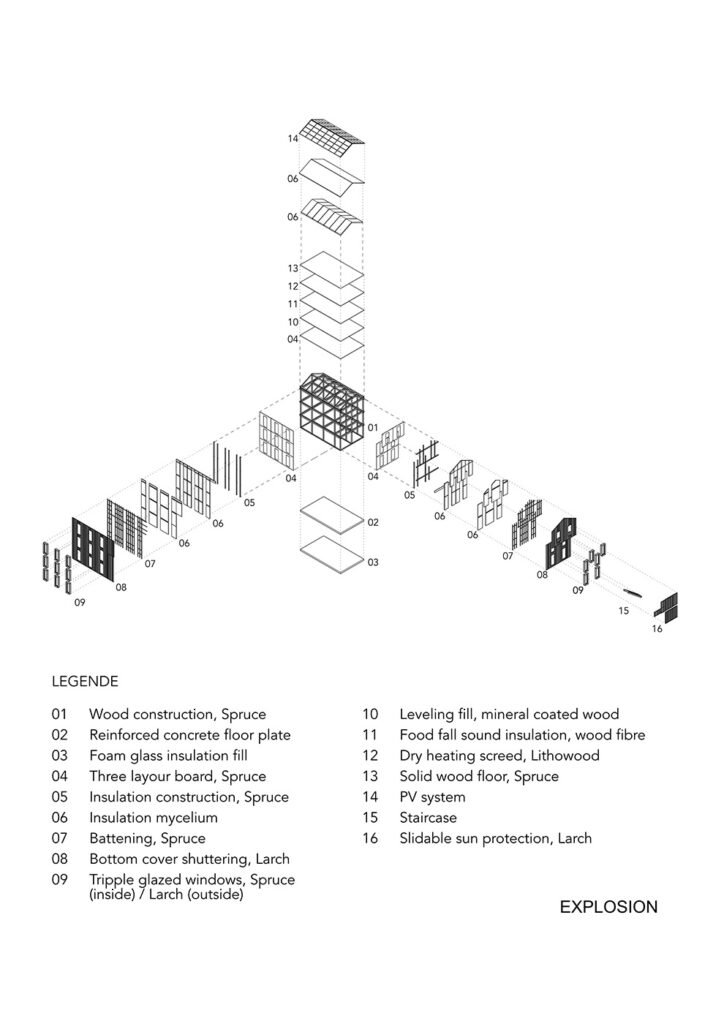
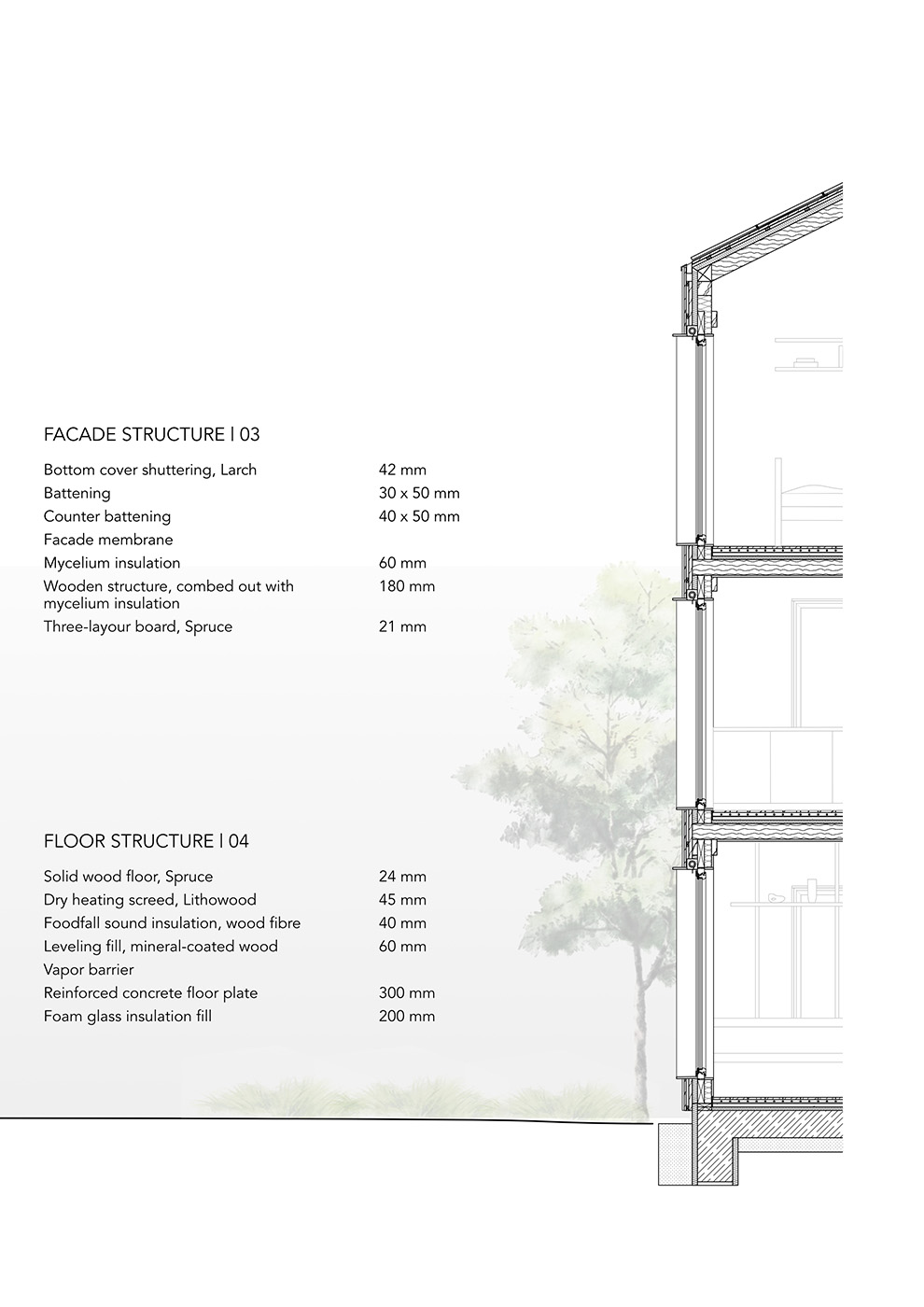
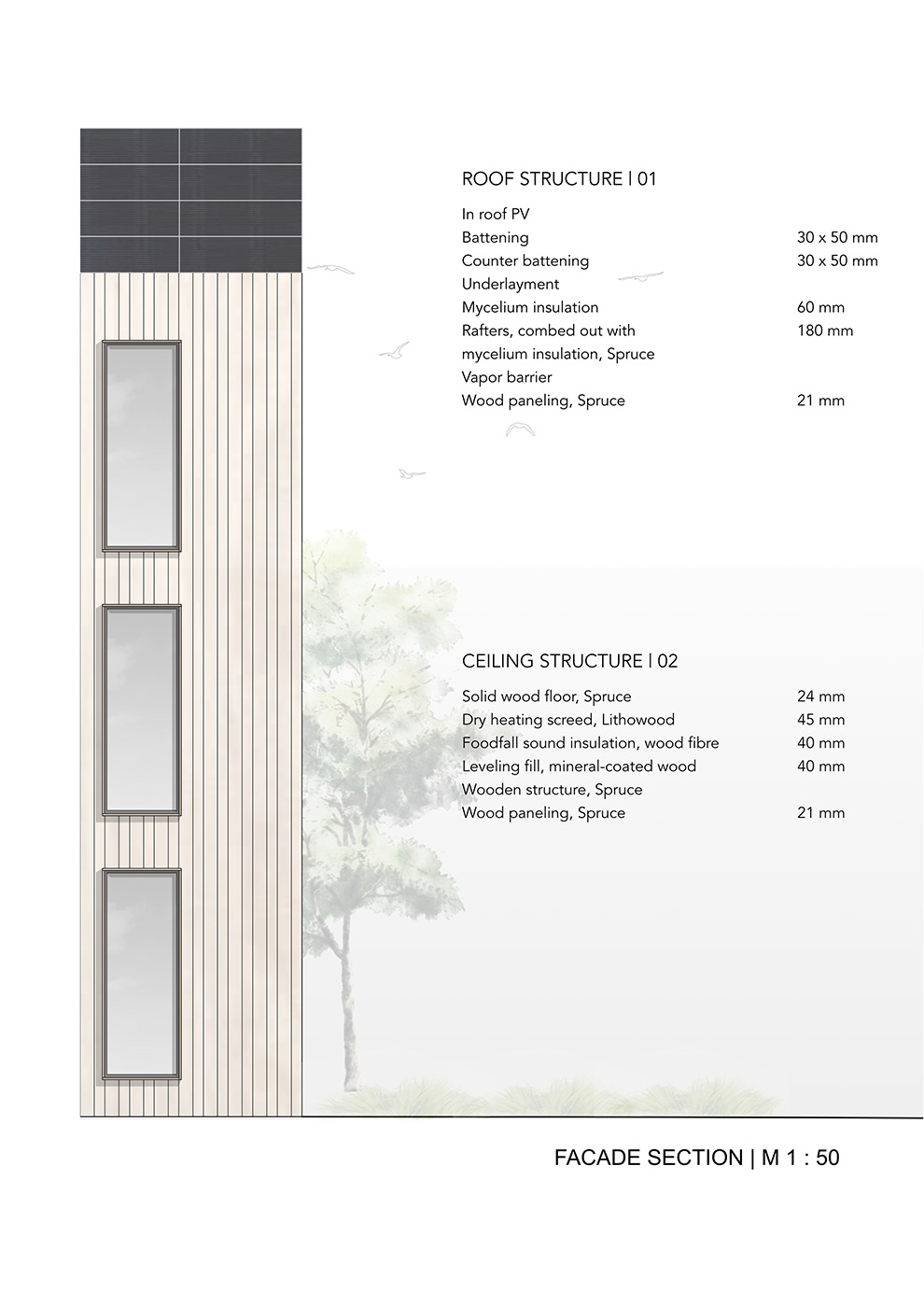
„USING MYCELIUM AS A CONSTRUCTIONAL DESIGN TOOL“ by Janina Lamm
The exhibition pavilion is located on campus of Hochschule für Technik. It is giving a space to exhibit student work and is available for bookings to have presentations there. It is constructed with regular drywalling system except the reinforcement is not achieved by plasterboard but by mycelium panels that are created with excess sawdust from the university’s own workshop. Everything would be put together temporarily and easy to be disassembled. To define the shape of the facade the growing shape of mycelium in a smaller model (1:25) is used as a design tool.
1:25 overview model, 1:1 mock-up
materials used: mycelium, sawdust, aluminum, flour, wood glue, screws, metal grid
substrate: sawdust from HFT carpentry

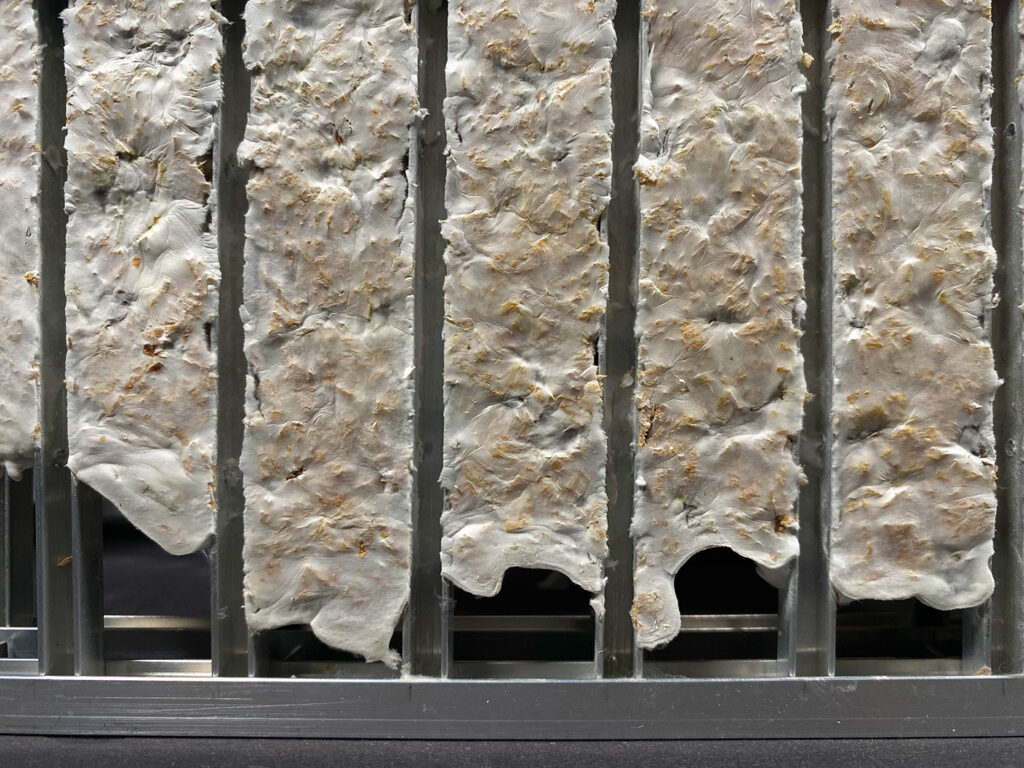

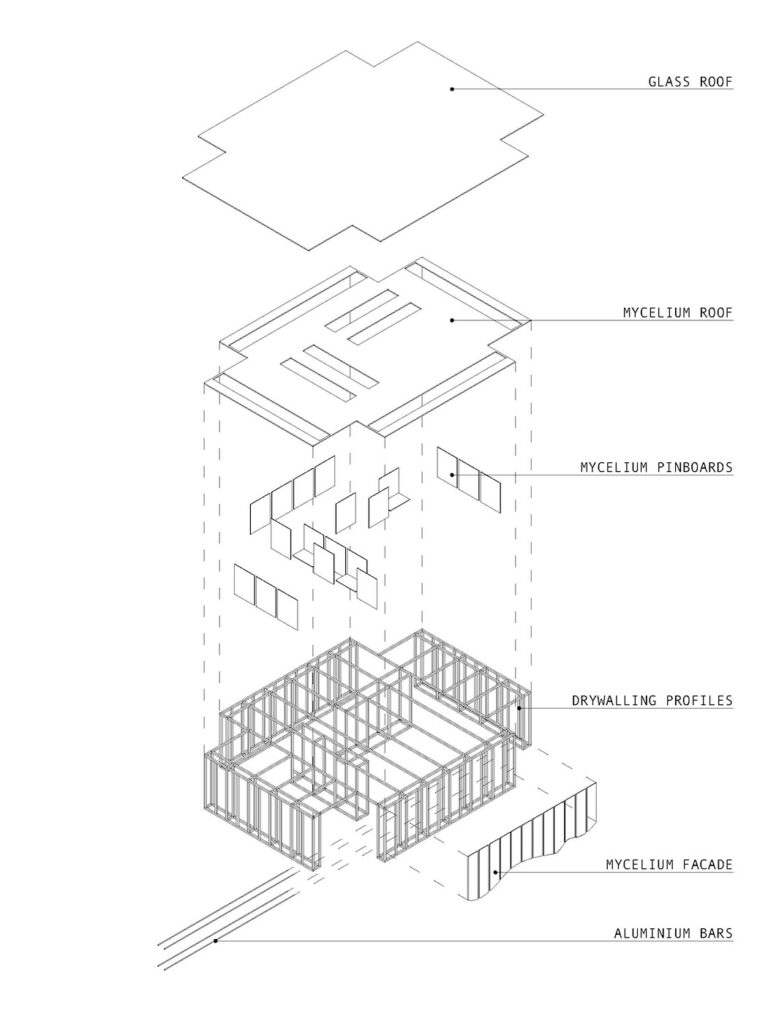
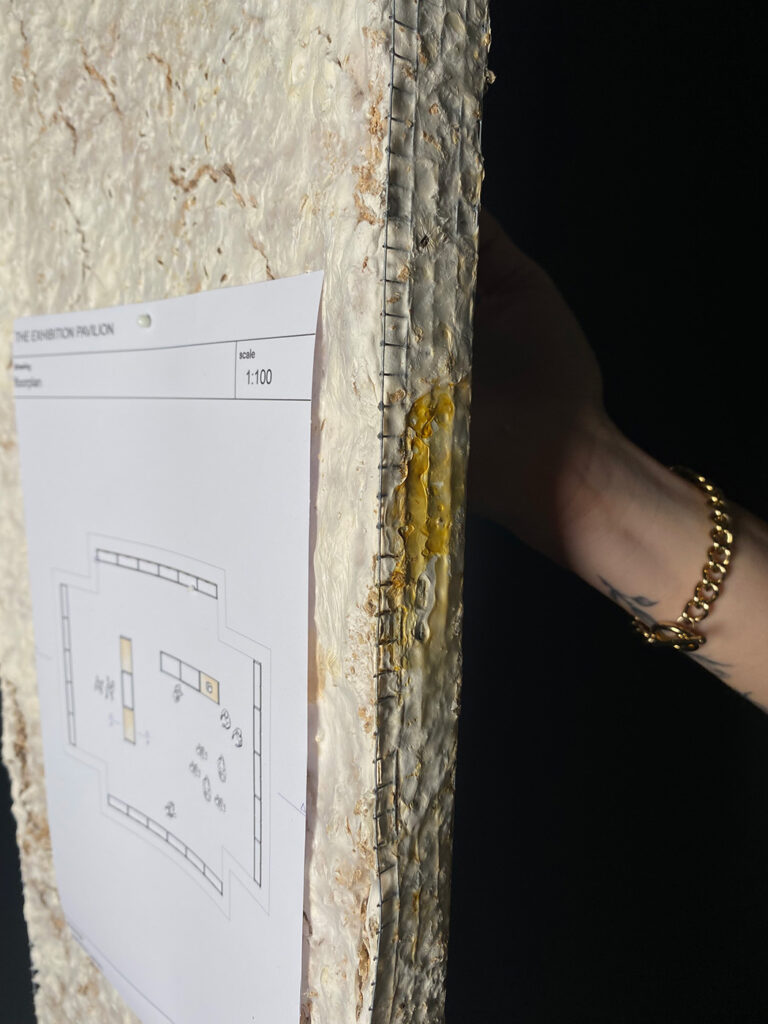
„REID“ by Kirsten Schäfer
In the attempt of establishing sustainability at all levels, our university asked us to invent a mycelium product for model making.
My answer is reid a finnboard made out of sawdust from inhouse workshops, reishi und agar-agar. You can us reid as you are used to us finnboard for your models. Reid comes as a set including a glue and an acrylic glass alternative. Ultimately if not needed anymore, simply composte your reid modul. Even better turn it into new reid boards to create a circular economy.
In the following you can see reid in use to visualize the idea for a residential bungalow in the Stuttgart Rohracker area.
1:100 building model
materials used: mycelium (reishi), wood, flour, starch, agar, water, dried flowers, psyllium
substrate: sawdust from HFT carpentry, smoke chips, psyllium husks
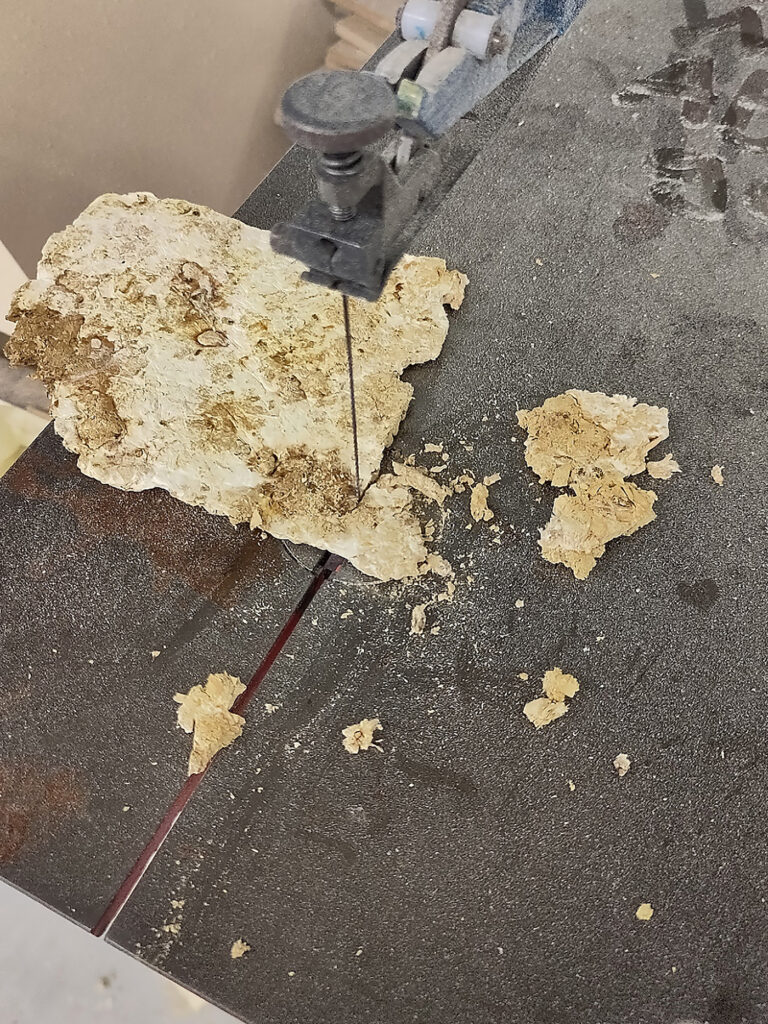

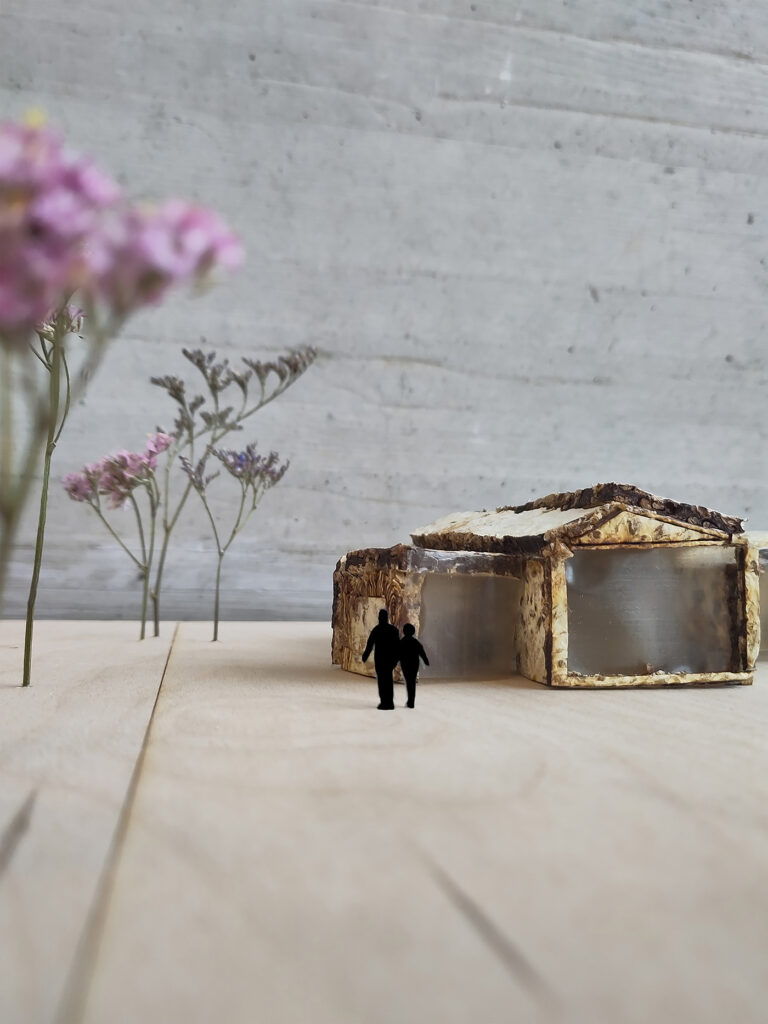
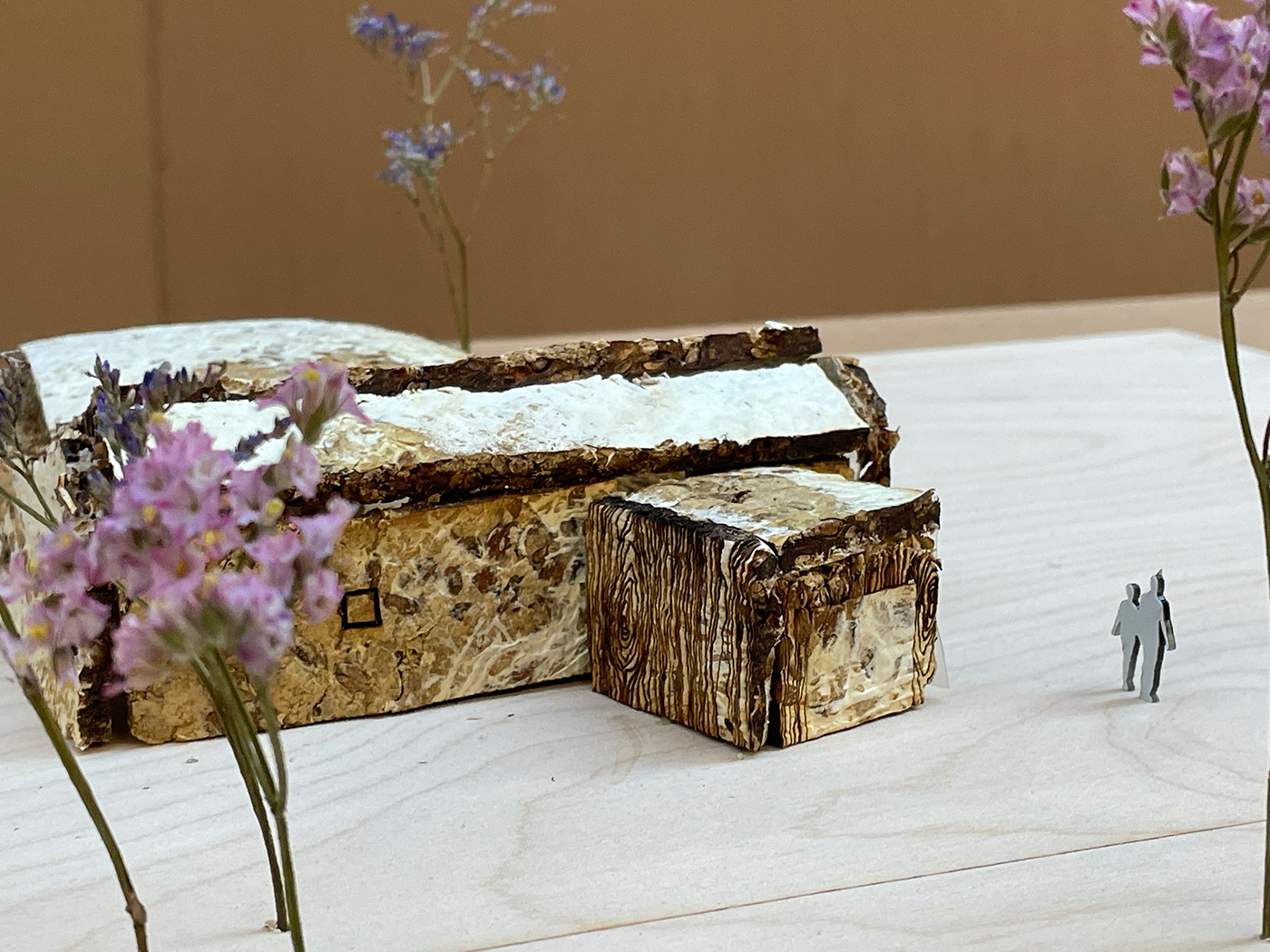



„MYKOLLECT“ by Leyla Minks, Luise Störkel
MYKOLLECT is a self-sufficient Tiny House, designed especially for mushroom pickers who are looking for a place to stay and share their collected mushroom species. The high windows allow for optimal natural lighting and create a connection between the interior and the forest environment. The solid timber construction forms the basic structure, while the exterior stands out with facade panels made of mycelium with a unique relief. The 50x50x5cm mycelium panels are planned to be cultivated with sawdust substrate and reinforced with glass fibre mesh for extra stability. To control the high risk of erosion of the organic material, the building was designed with a cantilevered roof and a raised plinth. This provides the mycelium panels with lasting protection from different weather conditions.
1:1 and 1:5 mock-up facade panels, 1:10 wall section model
materials used: mycelium, wood, wood glue, plastic angles
substrate: sawdust from HFT carpentry
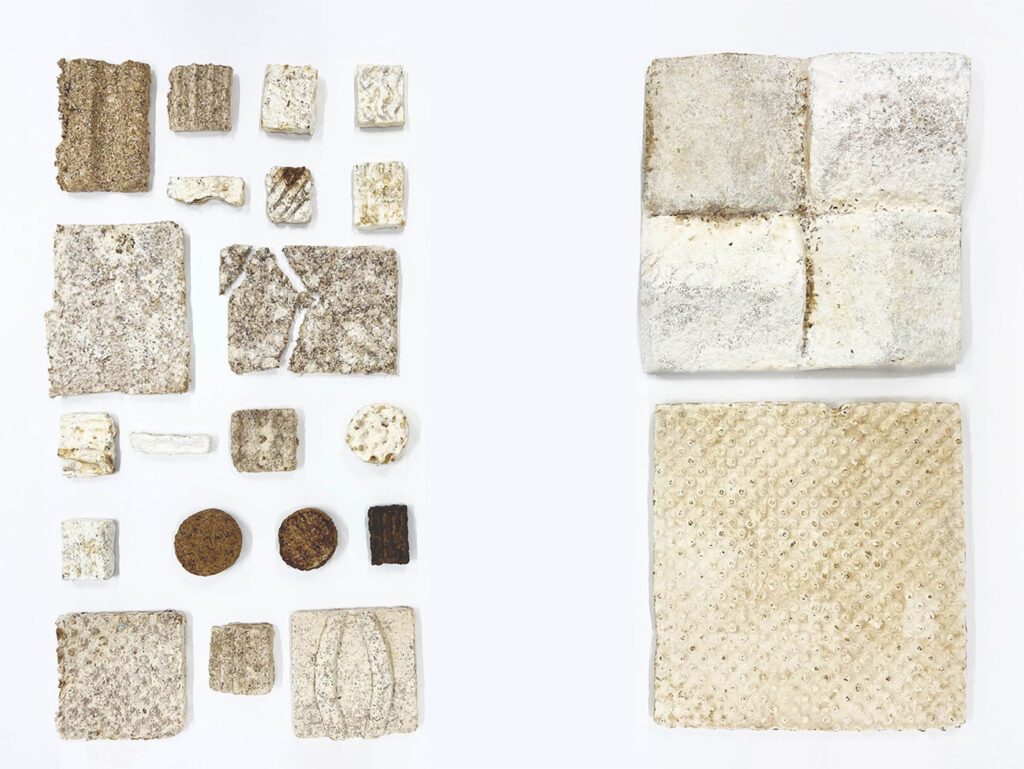
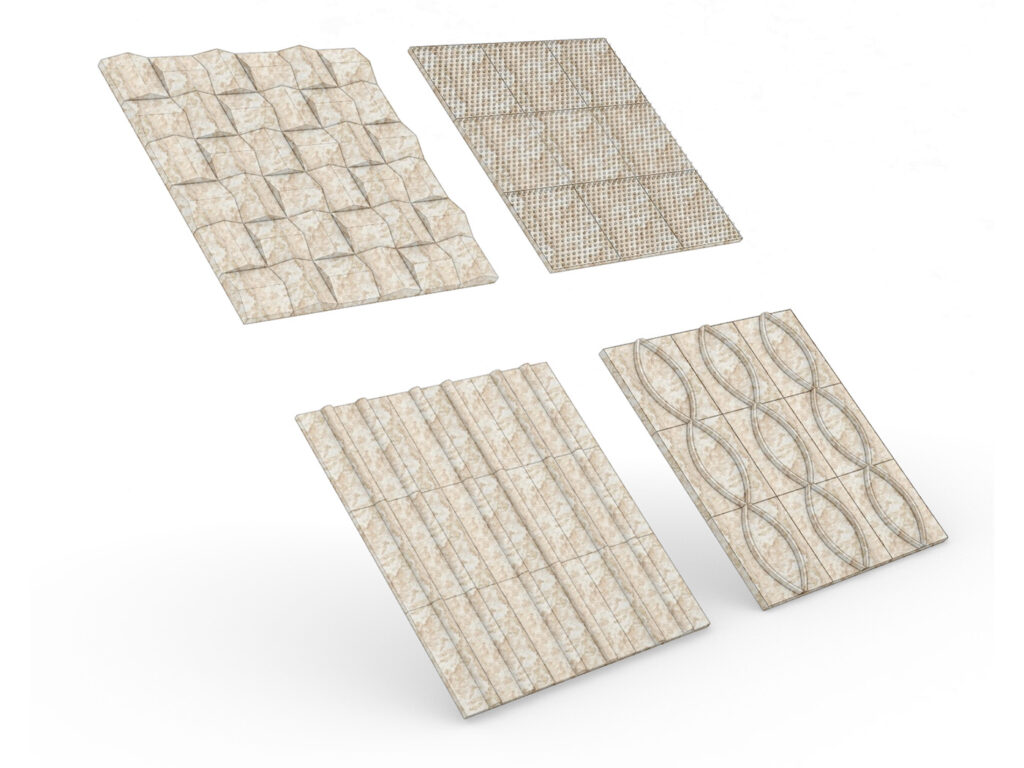
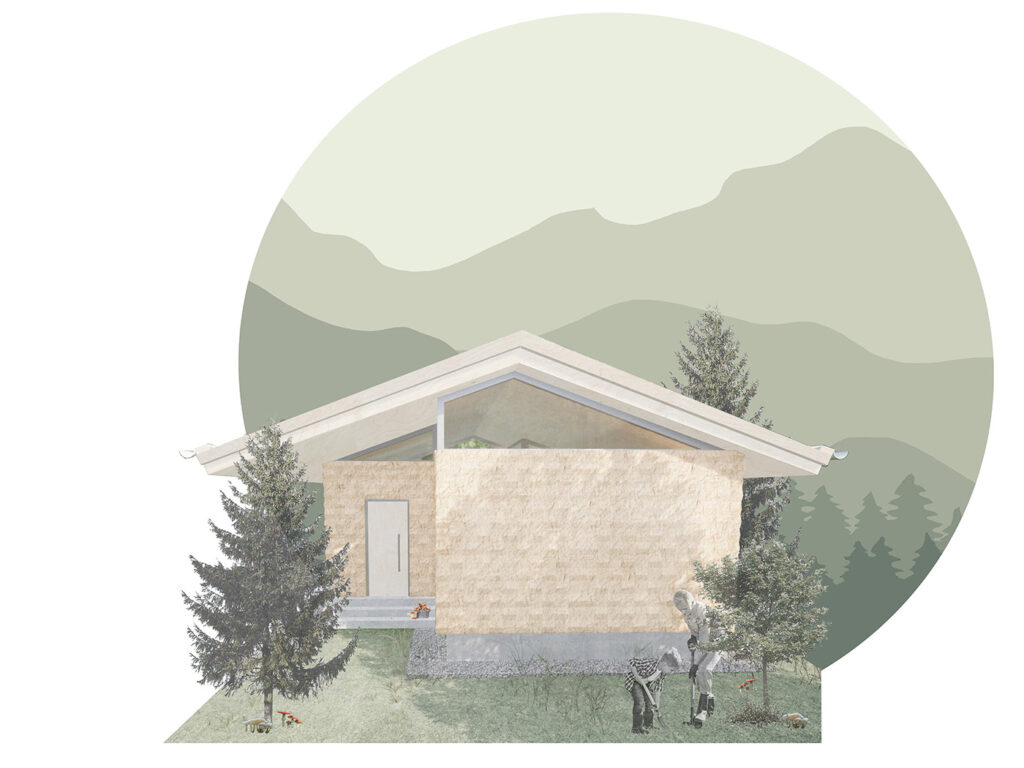

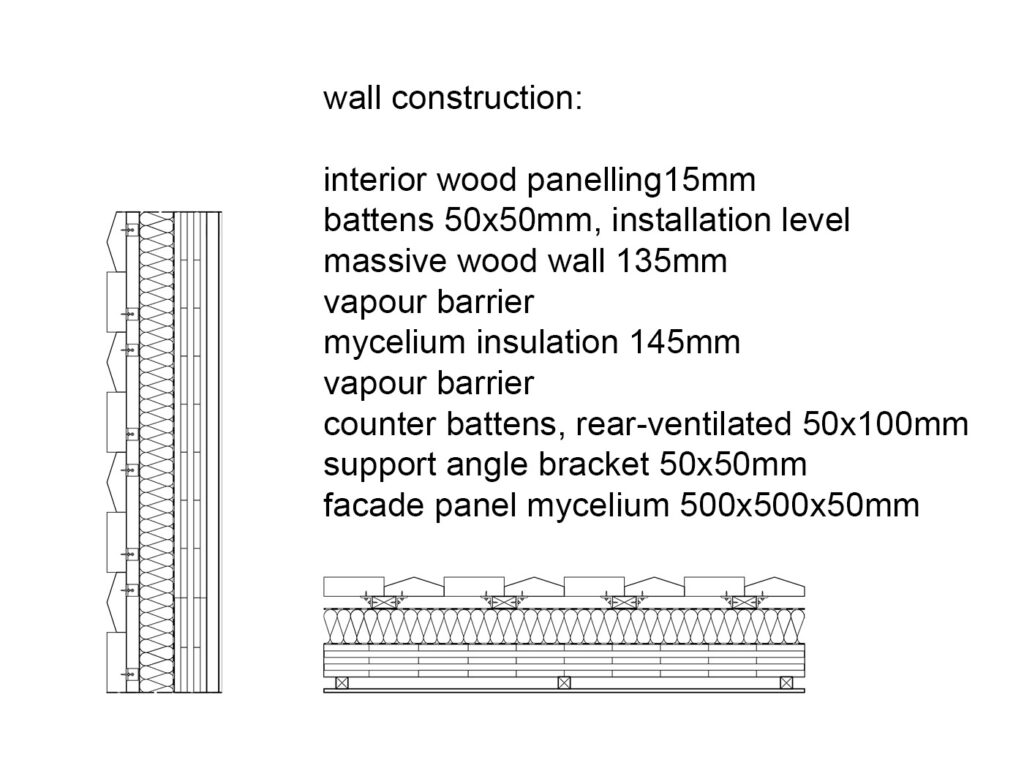
„MYCO BOARD“ by Annkathrin Böhm
MyCo Board is an eco-friendly alternative to traditional model construction materials like chipboard and MDF. Utilizing mycelium, this material offers comparable strength and fire resistance, addressing associated health and environmental concerns. The Toadstool Series, an application of MyCo Board, is designed for preschools with mycoboard legs that are variable in size and recycled children’s toys for adaptable seating surfaces. The collection aims to explore the possibilities pressed Mycelium composites can offer and to give an example of what a possible application could look like.
1:5 furniture model, 1:1 mock-up
materials used: mycelium, saw dust, 3d printed PLA
substrate: sawdust from HFT carpentry
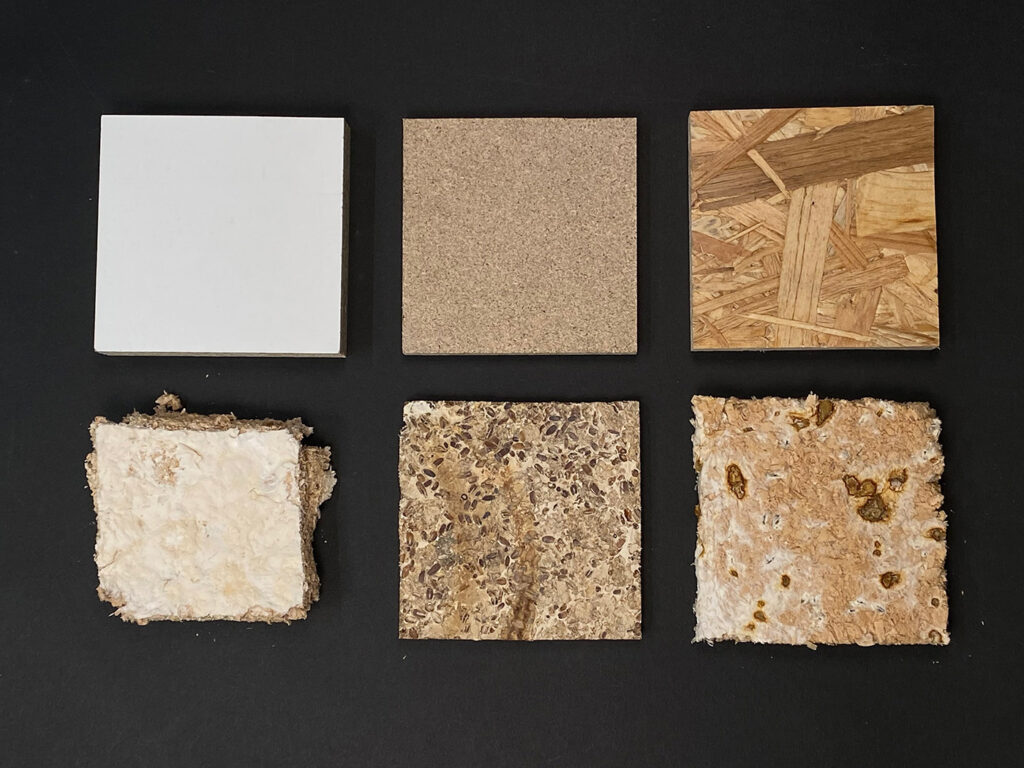
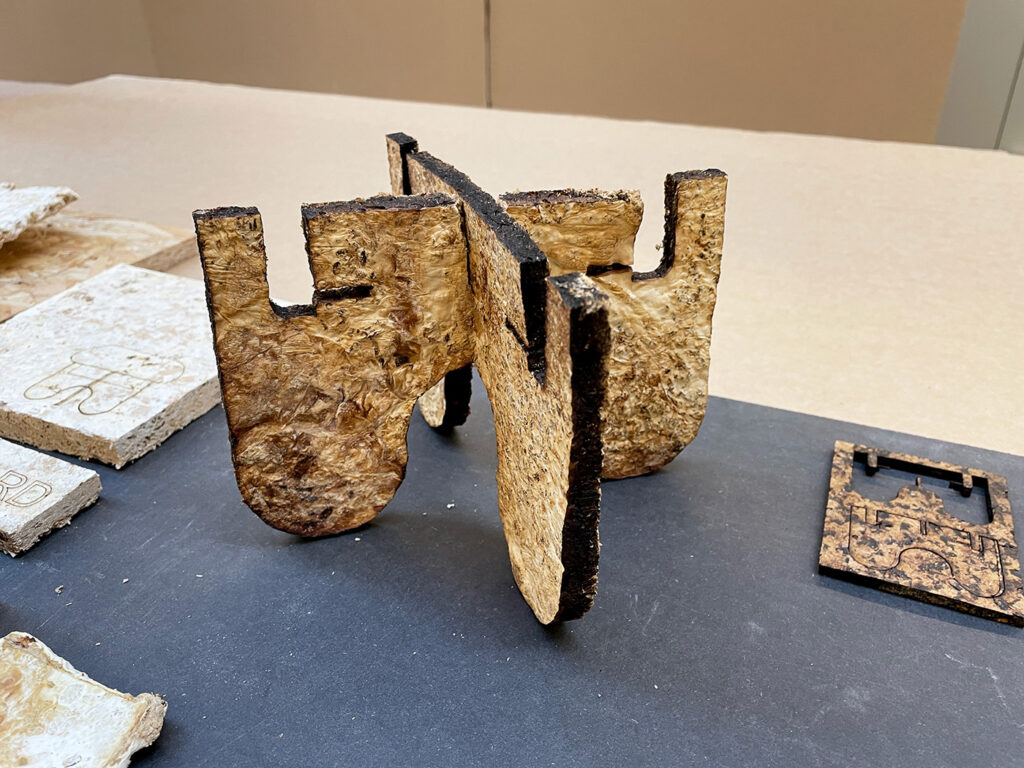
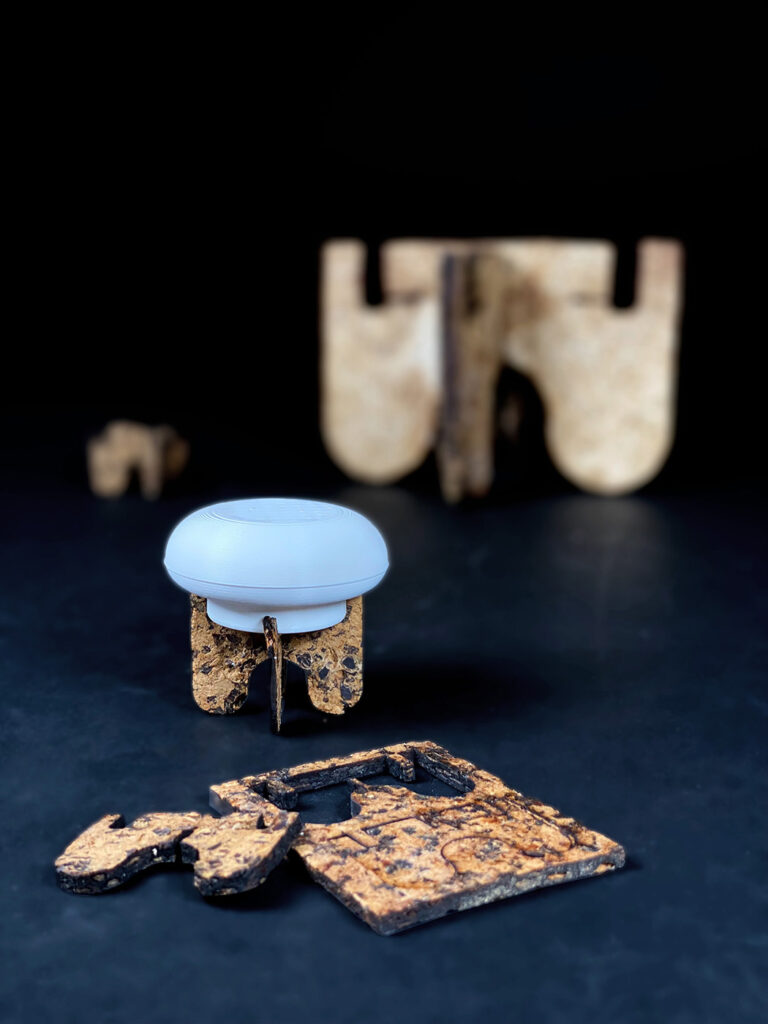

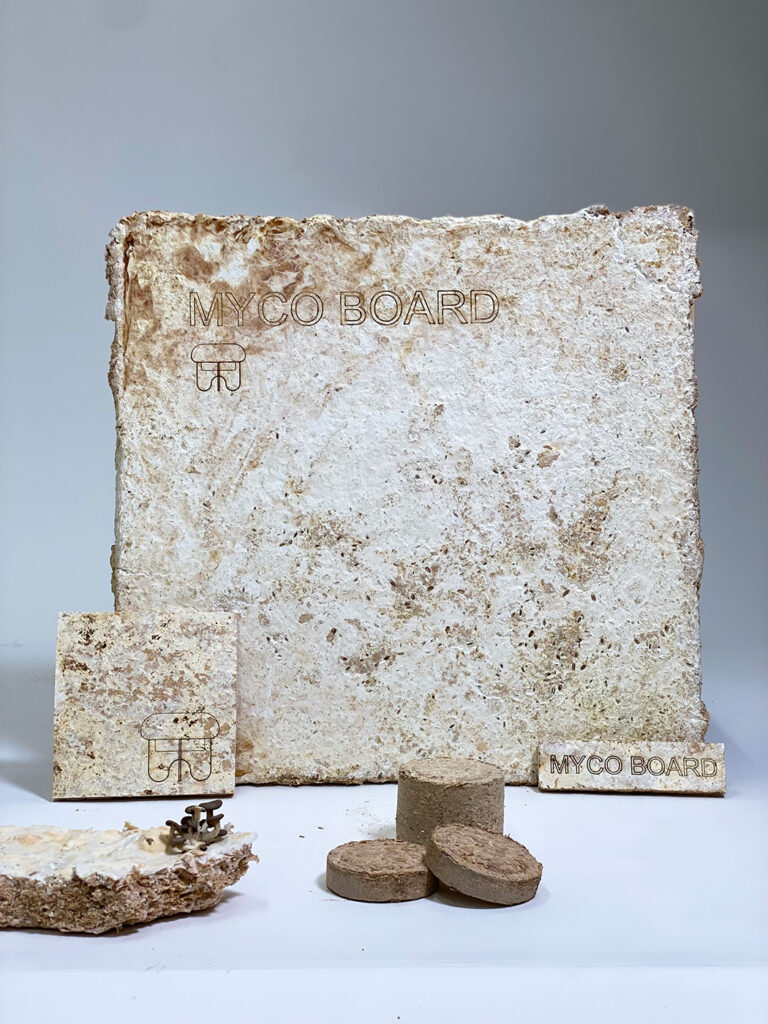

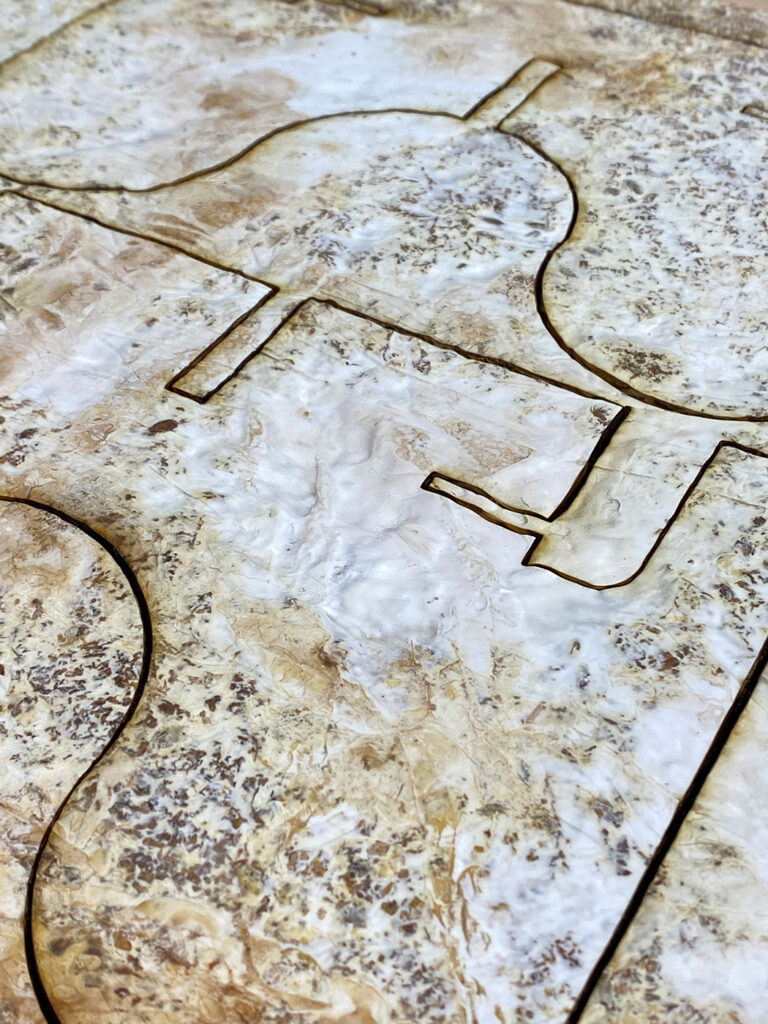
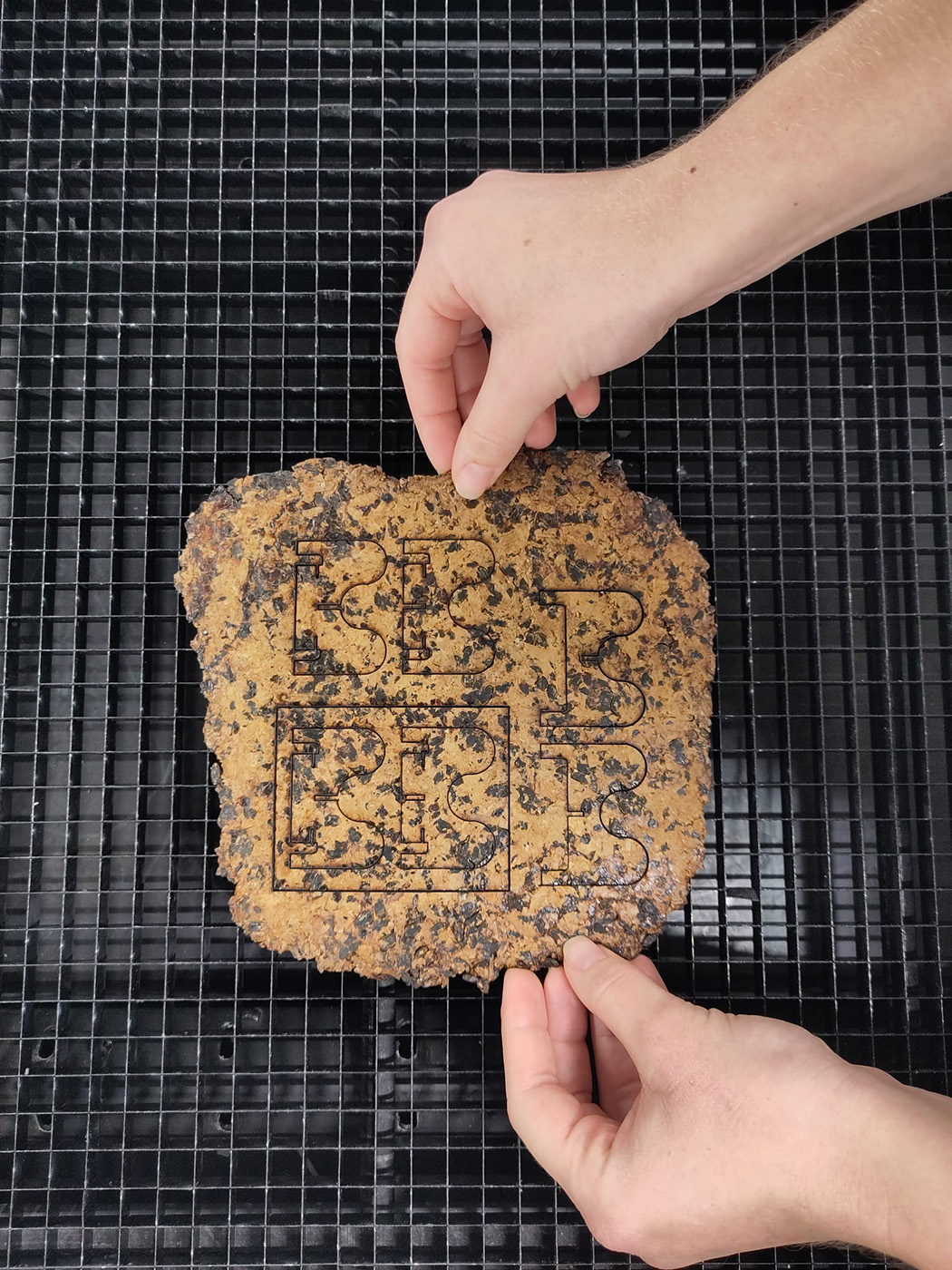
All works are displayed with the consent of the students.